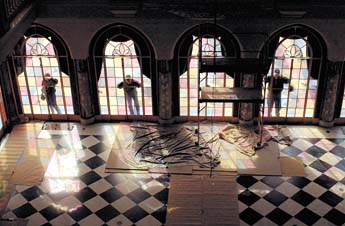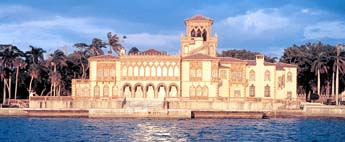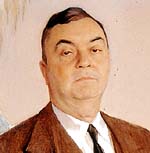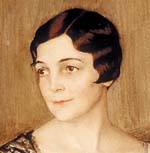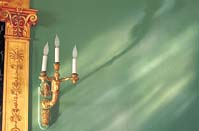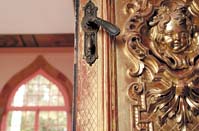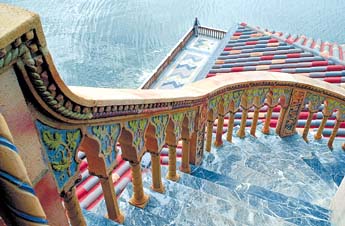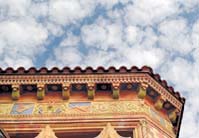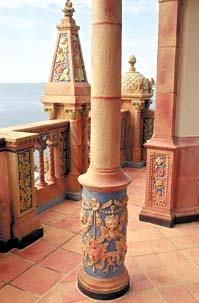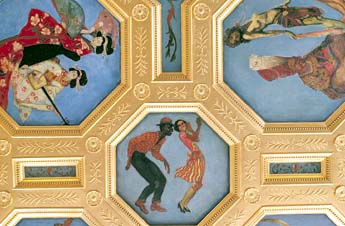Story
by Lennie Bennett St. Petersburg Times
SARASOTA -- The terra cotta palazzo shimmers in the glancing light off Sarasota Bay, a fantastical vision rising at the end of a long drive lined with royal palms and banyan trees. Ca d'Zan, John Nicholas Ringling called it, House of John in Venetian dialect. It was one of many dreams realized by a great dreamer. Ca d'Zan was built between 1924 and 1925 at a cost of $1.5-million ($15.8-million in today's dollars) in the Venetian Gothic style. The exterior was covered with a flamboyant mix of glazed tiles, mosaics, stained-glass windows and cast stone. Another $400,000 was spent to pack its interior with imposing furnishings and decorative objects from the 17th, 18th and 19th centuries. The grounds were lush with tropical plants, statuary and a rose garden. Twice, Ca d'Zan was almost lost, once to financial ruin, later to neglect. But after six years and $15-million, Ca d'Zan has been restored to its original glamor and reopens to the public on Saturday. It is one of Ringling's dreams that did not die with him.
The house that John built"If personality is an unbroken series of successful gestures, then there was something gorgeous about him," wrote author F. Scott Fitzgerald of Jay Gatsby.
The same could be said of John Ringling, a master of the grand gesture. He was the youngest son of poor, hard-working immigrants. His wealth was derived from a circus empire he built with his brothers during the first decades of the 20th century. He parlayed his share into a second fortune amassed through oil, railroad and real estate holdings. John and his beautiful wife, Mable, established a winter home in Sarasota after being snubbed by the old-money community in Tarpon Springs who considered them louche "circus people." Ca d'Zan was the Ringlings' response. They hired Dwight Baum, an architect popular with the wealthy, to design a house based on the villas of Tuscany and palaces of Venice that Mable had fallen in love with while traveling. Baum gave her the palatial scale and ornate details she requested both inside and out. A grand salon was paved with rare marble, punctuated by onyx columns and roofed with a stained-glass skylight. Every surface in the house was an opportunity for adornment. Even the insides of closet doors in bedrooms and medicine cabinets in baths were decorated with hand-painted scenes, each different. The Ringlings became serious art collectors, purchasing works by European masters, including four huge "cartoons" (painted studies for tapestries) by the baroque artist Peter Paul Rubens. At auctions, they often overpaid for furnishings that came with a provenance. They bought entire paneled rooms because they had belonged to the Astors, even though they weren't sure what to do with them.
In the first years, the good years, the Ringlings summoned hundreds of people to Ca d'Zan. He was ungainly and gruff, his wife reserved. But they were soon the toast of Sarasota, hosting musicales for several hundred favored guests on the vast marble terrace overlooking the water, or more intimate dinner parties for 20 served on Tiffany china and silver in the paneled dining room. He might give those who had arrived from the North in his private railcar a yacht tour of his coastal holdings. Or Mable could take them for a turn around the bay in her gondola. When Ringling led visitors up tower stairs to the fourth-story belvedere, he could sweep his arm in a broad circle and say, with truth, that he owned almost all the land visible from that height. Ringling had huge plans for the area. He started building a commercial and residential development called Ringling Isles, with a luxury hotel, shopping district and housing. A museum was under way for their art collection. He sat on bank boards, and she dressed in Paris couture.
Mable Ringling, who had lavished her time and attention on building and furnishing their home, who loved Florida and Ca d'Zan, lived there for just three seasons. In 1929 she died at 54 from diabetes and Addison's disease. John Ringling remarried the next year, but it was an unhappy union. The second Mrs. Ringling was never allowed to sleep in Mable's bedroom, which was kept as she had left it. Lest anyone miss the point, carved in large stone letters over the new museum entrance was Mable's name, next to John's. Disabled by strokes and other illnesses, Ringling survived Mable by only seven years. He had no children. At his death in 1936, John Ringling, because of the stock market crash and his spending habits, had lost almost everything except Ca d'Zan. Surrounded by creditors, even his claim to it was tenuous. Ringling wanted to give the mansion and museum to the state, which he hoped would preserve them forever.
A stately pleasure dome once moreIn 1946, after a decade of litigation over Ringling's estate, Ca d'Zan became the property of the state. It was opened to the public and became a popular tourist attraction, along with the museum. But little was done to preserve the house or its furnishings, and it did not enjoy the same curatorial oversight as the museum. Panels were ripped from walls, and the rococo furniture Mable loved was banished, deemed in poor taste. Rooms were repainted without thought to historic authenticity.
Money and attention were poured into the nearby museum, where, because of Ringling's financial problems, corners had been cut during construction. Structural problems had led to serious damage, and repairs had to be made to the building and the art. But in the early 1990s, the museum staff, alarmed at the house's deterioration, undertook a thorough review of Ca d'Zan. The state allocated $12-million, and private donors stepped up with $3-million more. The restoration and conservation were divided into three phases. First, the exterior of the building was renovated -- leaks sealed, repairs made, a new roof installed. Then the mechanical systems were updated. Those projects totaled $14-million. Finally, the interiors and furnishings were restored to their state during the Ringlings' time, for another $1-million. Those figures, say museum officials, would have been much higher without donations of supplies and labor from hundreds of local businesses "who felt it was like a civic duty to help with Ca d'Zan," said Aaron De Groft, deputy director of collections and programs at the Ringling Museum.
The results are stunning. Ninety-five percent of the original furnishings have remained in the house, including horsehair mattresses purchased from the Ritz-Carlton Hotel in New York. A few pieces of furniture retain their original upholstery fabric, but fiber, the material most vulnerable to the time's ravages, suffered the most. Upscale purveyors have loomed reproductions of fabrics and rugs. Artisans have repaired and restored furniture and other objects that were damaged, using photographs taken by Mable Ringling as references. Past criticisms of the interiors have been that the Ringlings eschewed authentic period furniture for gaudy reproductions, that their taste was unrefined, that they assembled a collection of decorative art based on quantity rather than quality. Those issues are valid if you judge Ca d'Zan by the standards of an art museum. But Ca d'Zan was first a home, and the Ringlings furnished it with things they loved. Burnished by time, the restored interiors hold their own just fine. Ca d'Zan, with its Beaux-Arts eclecticism of periods and styles, is a rollicking traipse back to a time when millionaires were minted as frequently as questionable stock certificates. It would no doubt please John and Mable Ringling that people will again throng to their palace on Sarasota Bay and marvel at the Ringling appetite for life and dreams. * * *
PREVIEW: Ca d'Zan, John and Mable Ringling's historic mansion, re-opens to the public on Saturday. Admission is included in the general admission to the Ringling Museum of Art, Circus Museum and grounds. Tickets are $15 for adults, $12 for seniors 55 and older. Children 12 and younger, museum members and Florida students and teachers with valid identification are free. The complex is open 10 a.m. to 5:30 p.m. seven days a week. Because of safety requirements, admission to Ca d'Zan requires a special timed-tour ticket, available on a first-come, first-served basis. Demand is expected to be high during the first weeks of opening. Beginning May 1, visitors may reserve a ticket for a small handling fee. Call (941) 358-3180. No backpacks or strollers will be allowed at Ca d'Zan. For the first time, the second floor will be handicapped-accessible, though only one wheelchair user at a time can be accommodated. Visitors are not allowed above the second floor.
|

